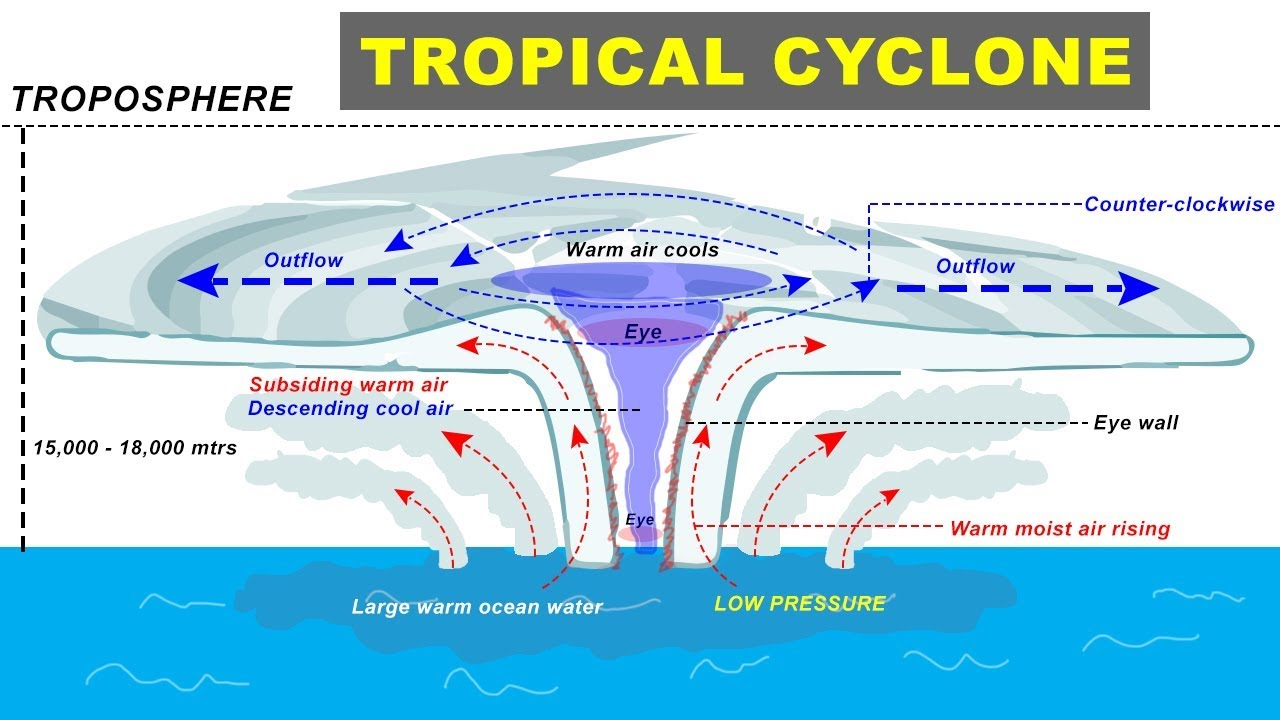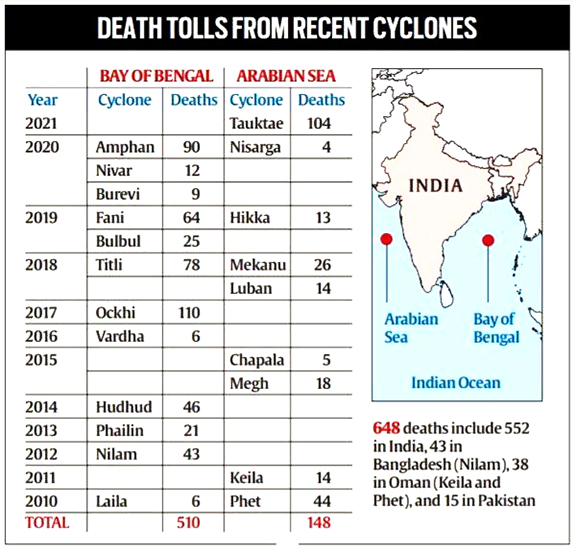Geography
Cyclone Yaas
- 29 May 2021
- 6 min read
Why in News
Recently, cyclone Yaas made landfall south of Balasore in Odisha.
- Earlier, another cyclonic storm named ‘Cyclone Tauktae’ had affected the Indian states of Kerala, Gujarat, Maharashtra, Goa and Karnataka, along with two Union Territories: Daman & Diu and Lakshadweep.
Key Points
- About:
- The cyclone has been named Yaas by Oman. The word Yaas has originated from the Persian language and means ‘Jasmin’ in English.
- Typically, tropical cyclones in the North Indian Ocean region (Bay of Bengal and Arabian Sea) develop during the pre-monsoon (April to June) and post-monsoon (October to December) periods.
- May-June and October-November are known to produce cyclones of severe intensity that affect the Indian coasts.
- Classification:
- It has been classified as a very severe cyclone.
- The India Meteorological Department (IMD) classifies cyclones on the basis of the maximum sustained surface wind speed (MSW) they generate.
- The cyclones are classified as severe (MSW of 48-63 knots), very severe (MSW of 64-89 knots), extremely severe (MSW of 90-119 knots) and super cyclonic storm (MSW of 120 knots or more).
- Areas Affected:
- It affected the bordering regions of West Bengal and Odisha and weakened into a cyclonic storm, leaving behind a trail of destruction on the eastern coast.
- Bay of Bengal Getting Warmer:
- The Bay of Bengal, where cyclone Yaas has formed, is at least two degrees warmer than what is normal for this time of the year.
- The north Bay of Bengal is exceptionally warm with temperatures up to 32 degrees.
- Tropical Cyclones:
- A tropical cyclone is an intense circular storm that originates over warm tropical oceans and is characterized by low atmospheric pressure, high winds, and heavy rain.
- A characteristic feature of tropical cyclones is the eye, a central region of clear skies, warm temperatures, and low atmospheric pressure.
- Storms of this type are called hurricanes in the North Atlantic and eastern Pacific and typhoons in SouthEast Asia and China. They are called tropical cyclones in the southwest Pacific and Indian Ocean region and Willy-willies in north-western Australia.
- Storms rotate counterclockwise in the northern hemisphere and clockwise in the southern hemisphere.
- The conditions favourable for the formation and intensification of tropical storms are:
- Large sea surface with temperature higher than 27° C.
- Presence of the Coriolis force.
- Small variations in the vertical wind speed.
- A pre-existing weak low- pressure area or low-level-cyclonic circulation.
- Upper divergence above the sea level system.
- Naming of Tropical Cyclones:
- According to WMO (World Meteorological Organization) guidelines, countries in every region are supposed to give names for cyclones.
- The North Indian Ocean Region covers tropical cyclones formed over Bay of Bengal and Arabian Sea.
- The 13 members, which come under the region, are Bangladesh, India, Maldives, Myanmar, Oman, Pakistan, Sri Lanka, Thailand, Iran, Qatar, Saudi Arabia, the UAE and Yemen.
- IMD, one of the six Regional Specialised Meteorological Centres (RSMC) in the world, is mandated to issue advisories and name tropical cyclones in the north Indian Ocean Region.
- It is an agency of the Ministry of Earth Sciences.
Bay of Bengal vs Arabian Sea (Cyclones)
- Bay of Bengal:
- As it is concave or shallow where when strong winds push water, it gets concentrated as a storm.
- It is shaped like a trough that makes it more hospitable for storms to gain force. Moreover, the high sea surface temperature makes matters more worse in the Bay triggering the intensity of the storms.
- Additionally, it gets more rainfall with sluggish winds and warm air currents around it that keep temperatures relatively high all year. The constant inflow of fresh warm water from the perennial rivers like Brahmaputra, Ganga makes it further impossible to mix with the cooler water below.
- Lack of landmass between the Pacific Ocean and the Bay of Bengal tend cyclonic winds to move into the coastal areas causing heavy rainfall.
- The absence of air movements from north-western India towards the Bay in the post-monsoon phase is also another reason for the chances of cyclones in the Bay of Bengal.
- Arabian Sea:
- It is much calmer as the stronger winds help dissipate the heat and lack of constant fresh water helps the warm water to mix with the cool water underneath, reducing the surface temperature.
- The Arabian Sea enjoys the locational advantage as the winds from the Pacific Ocean encounter the Western Ghats and the Himalayas cutting down on its intensity and sometimes never reaching the Arabian Sea.






